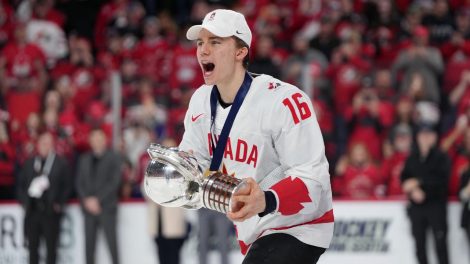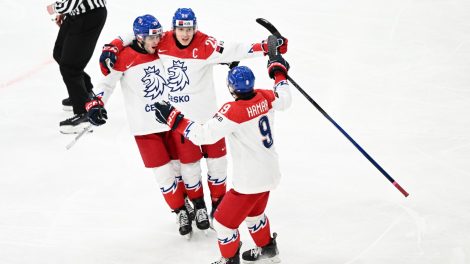MONTREAL – You had to feel a special sense of dread when Nicolas Roy skated up to the puck sitting at centre ice at 11:15 p.m.
It was the worst possible situation. More than 19,000 at the Bell Centre and millions across Canada tracking every shift through 60 minutes of regulation, 20 minutes of overtime, and nine-tenths of a shootout.
And it’s your turn.
Roy didn’t have a chance to win it for Canada in the fifth round of the shootout in the gold medal game against the U.S. He had a chance to keep his team alive for another round.
Roy had watched four of his teammates come in on American netminder Tyler Parsons and try a variety of moves. Roy had watched Dylan Strome try to go five-hole only to have Parsons plug the gap. Roy had watched Mathew Barzal put the puck wide of the net on a backhand. Roy had watched Tyson Jost try to stretch out Parsons only to have the goalie slide hard to his stick side and seal off the shot. Roy had watched Anthony Cirelli try to get a backhand over Parsons’s outstretched leg and come up a couple of inches short.
Or maybe he averted his eyes. Maybe he couldn’t bring himself to watch. No doubt he had hoped his four teammates had put the puck past the American and render a fifth shot in the tiebreak unnecessary. If it had worked out that way, Roy and the Canadian side would have been collecting their gold medals at about 11:10 or so.
Not how it turned out.
Roy had a great tournament, one of the surprise players for a Canadian team that exceeded the expectations of many to make it to the final and play the U.S. to an 80-minute standstill. Just a couple of shifts into the third period, Roy had put his team ahead 3-2 when Jost, industrious on the cycle, found him in the faceoff circle and the big centre from the Chicoutimi Sagueneens wristed the puck past Parsons, grazing the last couple of inches of the shaft of the goalie’s stick.
It looked like that goal was going to stand as the winner when Mathieu Joseph beat Parsons and padded the Canada lead two minutes later. Roy’s goal looked like it would be an exclamation point at the end of a tournament that would make him the most famous resident of Amos, a mining and lumber town in northwestern Quebec.
But late goals by Kiefer Bellows, his second of the game, and Colin White brought the U.S. to even terms and flipped the script.
When Roy picked up the puck at centre ice and crossed the blue line, his tournament and his teammates’ came down to the next few seconds, a couple of breaths, maybe a dozen beats of his heart. The foreknowledge that all his good work in this tournament would be lost or forgotten if somehow the puck didn’t find the net probably had to make his heart beat a little faster. In that moment the world outside the boards at the Bell Centre ceased to exist.
Give Roy points for nerve. He didn’t just shoot and take his chances, what many players regards as sucking out. He actually raised his left skate off the ice as he prepped his deke.
If he scored, it was going to be a highlight-reel move, whether Canada would win in a coming round or not.
He didn’t score. In fact, he didn’t come particularly close.
Okay, Roy might have had Parsons set up, might have had him leaning, but he overskated the puck. The puck rolled to Parsons like a draw to the front of the eight-foot ring on a curling sheet. If Parsons didn’t get in the way of it, it might not have had enough steam to cross the goal-line anyway.
The Americans poured off the bench and mobbed Parsons. Canada has come away with a single gold-medal at the world juniors since John Tavares led the way to the championship in Ottawa. And they needed Connor McDavid to do it.
Roy didn’t come out to take questions from English-speaking reporters after the game but his teammate Thomas Chabot, the tournament’s best defenceman and the home team’s most valuable player by a big margin, offered his take on the stream of consciousness in shootout.
“We go in [the] shootout during junior games and we feel like we have pressure,” Chabot said. “I couldn’t imagine all five of our guys on our team that stepped on the ice to go in the shootout [with the crowd] standing up and cheering. It’s a lot of pressure but I’m pretty sure he tried to do his move that he was confident with and it didn’t work. It could’ve worked.”
The standing-up-and-cheering is the easy part. It’s the funereal silence that follows a miss that’s unimaginable. The minutes, the hours, the days, and however long for the psychic wound to heal.
Having skated the same patch of ice in the shootout’s fourth round, Cirelli knew what Roy was going through even more intimately than Chabot. “It’s a hard way to lose but it’s what’s in the rule book,” Cirelli said. “You know what you want to do. But it’s a shootout.”
Yeah, it’s a shootout. It’s guaranteed to be awful for some poor soul. Proof that authors of the rule book care little about fairness and know nothing at all about the human heart.








